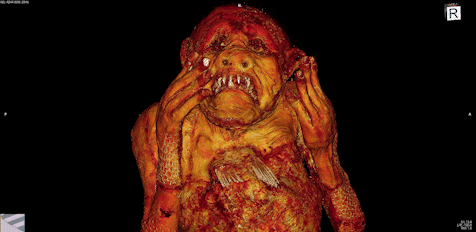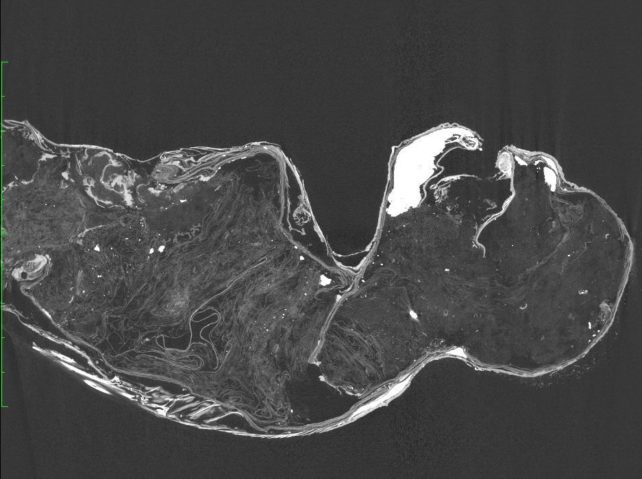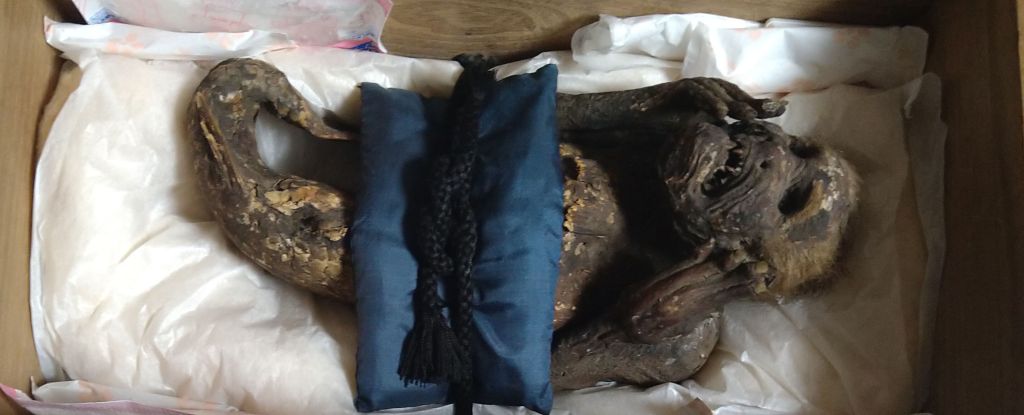Products You May Like
An in-depth analysis has finally revealed the make-up of a bizarre ‘mummified mer-monkey’ housed at the Enju-in Temple in Asakuchi City, Japan.
The peculiar artifact has been an object of curiosity for decades, though according to an accompanying note it’s oceanic origins are purported to date back centuries. At a total of 30 centimeters (1 foot) in length, the body consists of a furred, primate torso and what appears to be a scaly fish-tail, with two human-like hands framing a frozen grimace bristling with tiny, pointed teeth.
In Japanese mythology, patchworks of fish and human body parts are referred to as a ningyo – aquatic creatures that are less alluring than the western mermaid though just as steeped in lore and tradition.
Tucked inside its paulownia wood storage box, a hand-written note suggests that it was caught off the coast of what is now Kochi around 1740.
Since February 2022, scientists at the Kurashiki University of Science and the Arts (KUSA) have been working with the temple to figure out what this oddity might be.
Now, they have revealed whether hoax, fraud, or work of art, the mer-monkey is no animal at all, but a work of human artifice.

A number of what appear to be mummified ningyo can be found across Japan, many in the possession of temples and museums and mainly dating to the Edo Period (1603-1868). Since nothing of the kind has ever been found living, the origins of these jigsaw-puzzle creatures is a puzzle.
To tease apart the construction of at least one of the specimens, the KUSA team worked with the temple to non-destructively examine the Enju-in artefact. The examination included a visual assessment, X-ray imaging, X-ray CT imaging, optical and electron microscopy, fluorescent X-ray analysis, DNA analysis, and radiocarbon dating.
And the most glaring thing was, aside from a mandible, the ningyo is completely lacking in skeletal architecture – so it’s not even, as was the case with P.T. Barnum’s Fiji Mermaid hoax, some ghastly Frankenstein of monkey and fish corpses sewn together.

The scans revealed that the object is a hodge-podge of parts. No wood was used in the mer-monkey’s construction; instead, it’s mainly made of cloth, cotton, and paper, coated in a substance made by mixing charcoal powder or sand with a paste. The head is mostly cotton, and coated in a substance like gypsum.
The hair on the head is animal hair, and the scales come from two kinds of fish. The upper body is covered in skin from puffer fish, and the lower body the scaly skin of a species of croaker. The nails on the five fingers are animal keratin, likely some kind of horn. The jawbone was from some sort of carnivorous fish.
Meanwhile, radiocarbon dating of some of the scales belie the handwritten note in the mermaid’s box, suggesting that the creature was fabricated over a century later.
“The fish body of the ‘Dried Mermaid’ in the collection of Enju-in is covered with the skin of a croaker, and the upper body is made of cloth and paper,” the researchers conclude.
“It is made of laminated paper and puffer fish skin, with cotton and other fillings and a plaster-like substance as the base, and is presumed to have been made around the late 1800s.”
How the mermaid came to be in the possession of the Enju-in Temple is still a mystery. Although the mermaid’s construction has been demystified, it remains an important artifact of its time, and it will be returned to its home where it will remain under the care of the priests.
